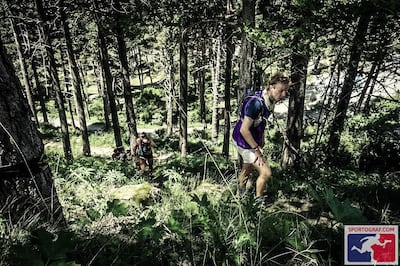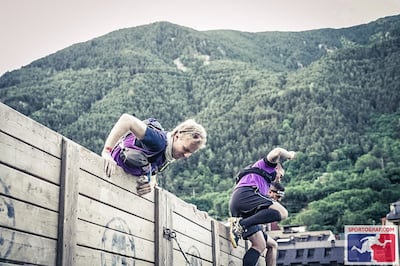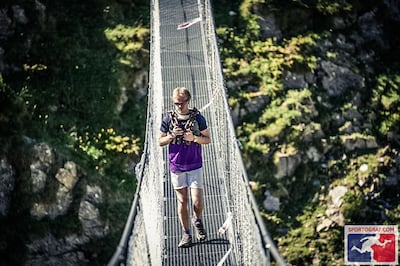
I can pinpoint the exact moment when it began to sink in how completely f**ked I was for this ultramarathon. As soon as I laid eyes on my competitors, with their biceps at least three times the diameter of mine, I knew I was in for a wild ride.
Since October, I’ve been training for a Spartan Ultra in Andorra – a race which is 50km, high in the Pyrenees. And it includes 60 obstacles – each one designed to break me down.
And if I fail an obstacle? 30 burpees.
Madness.
READ MORE
Many said I was nuts to attempt this, especially because a year ago the most I’d ever run was maybe 5km. And while there’s truth to these accusations of lunacy, here I was, 1,200 metres above sea level, surrounded by towering mountains, with my two Spartan running mates, ready to give it a go.

The toughest type of Spartan course is a Beast, which usually involves 21km and 30 obstacles. So what’s an Ultra? Complete a Beast twice and a little extra. No problem for us wannabe mountain goats, right?
The goal: Merely to finish the race within the allocated time limit of 16 hours.
The real goal? Prove that with enough training, obstacle-filled ultramarathons aren’t some ludicrous sport for beardy Vikings and Olympic jocks – and even I can give one a go.
So here goes.
Wakeup for Jack, Johann and I was at 4am (which still felt pretty much like 3am Irish time to me). The race was brought forward by an hour to get ahead of the storm forecast in the evening. Feck all sleep for us then.
We arrived shortly before our start-time at 6:50am. Hydration pack? Check. Protein bars? Check. Carbohydrate gels and gummies – the ones that won’t make me poo off the side of a mountain? Check. And with some hearty chanting from our fellow Spartans, we began our odyssey.
Setting off from the small town of Encamp, nestled into a valley flanked on all sides by steep mountains, we hoped the beginning of the race would grant a brief buffer before the surrounding Pyrenees. Nope.
About five minutes in we picked up sandbags and made for the edge of town and soon began climbing a steep mountain trail. Suffice to say I never want to see a sandbag again.

No sooner had we climbed up the mountain before we zipped back down again – thankfully we ditched the sandbag at the top. Flat terrain is something of a myth in Andorra, but the spectacular views made it worth it. All that training in the Phoenix Park seems like child’s play now.
No hike in Ireland could ever prepare us for the Pyrenees, and as expected the day consisted of trudging up rocky paths along sometimes sheer cliffs and pelting it back down to even up our pace. We would need to average 15 minutes per kilometre to finish on time, so taking advantage of the downwards slopes was key.
Being really high up and all, the thin air made sure most climbs left us out of breath. Plus, running through a forest in peak-pollen season did a number on my breathing too.

I’ve always been suspicious of the number 13, so I suppose it was fate that landed me cramps 13km in. Leg cramps can be stretched out here and there, but when you’re pushing continuously, they’ll keep coming back like some dog retrieving a stick – except this analogy involved lots and lots of pain.
The dreaded barbed wire crawl was more menacing than difficult really. Not as mucky as some of the other Spartan races I’ve seen but avoiding the cow crap certainly made up for it.
The spear throw was certainly the most satisfying. Thrusting a spear through the air and nailing it on a hay bale was the confidence lift we needed among some of the more miserable obstacles – apart from Jack, who seems doomed never to land this one. No need to worry about this fella with a spear in hand.
The chain carry was by far the most difficult thing I’ve ever done physically. Imagine a thick rusty chain wrapped around your shoulders while you walk across a rope bridge, up a hill and back again while having cramps in both legs. Every step was agony.

There were some good bits too throughout the day. By far the best part was Johann’s need to habitually pick up every gel wrapper littered along the course. Seeing that exhausted man stopping to stuff litter in his pockets was as hilarious as it was admirable. But soon things took a turn, which unfortunately did not involve any Hulk-related transformation to save the day.
As we approached the halfway point, our bodies began to flounder at the task we’d set ourselves. The lads’ knees began to give in, and I was hitting my limit. So perhaps unsurprisingly, after 33km, dozens of obstacles, 2,450m of total ascent: we called it a day.
No medal or glory was worth the serious injury awaiting us if we pushed on. Despite not smashing our goal of merely finishing the race, I’ve never been more proud.

A year ago I would have laughed at you if you suggested I could run for almost 9 hours as high as 2,200m (7,200ft) and make it back in one piece. That night we ate like kings and slept for more than 12 hours.
Some might see what we attempted as a spectacular disaster, but for us there’s no doubt how successful this has been.
The physical and mental benefits these past eight months have been life changing. The camaraderie and friendships forged go beyond any temporary pain left in Andorra. And in a way this has all been a rather ridiculous excuse to do all that.
We’re already planning to run a race on some more manageable terrain in Wales or Kent. It’s a shame because although the Pyrenees were huge and gigantic and all the big words combined, the pints were stupidly cheap.
So while I recommend setting yourself an exercise goal, perhaps stick to something more sensible than one of the hardest Spartan races in the world – couch to 5k anybody?
- Sign up for one of The Irish Times’ Get Running programmes (it is free!). First, pick the eight-week programme that suits you.

- Beginner Course: A course to take you from inactivity to running for 30 minutes.
- Stay On Track: For those who can squeeze in a run a few times a week.
- 10km Course: Designed for those who want to move up to the 10km mark. Best of luck!














